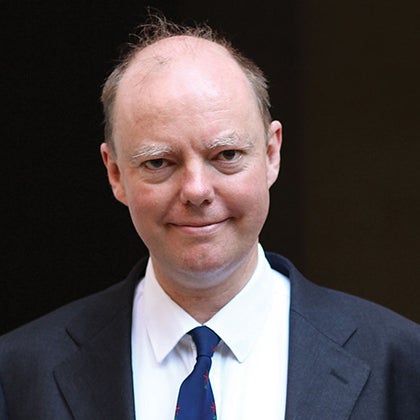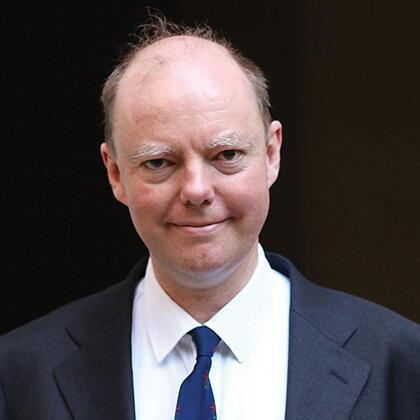Stroke in the Elderly: Slowly Retreating
Share
- Details
- Transcript
- Audio
- Downloads
- Extra Reading
The risk of stroke steadily increases with old age, but in relative terms both the risk of having a stroke and disability as a result of stroke are decreasing. It remains one of the most feared, and common, serious medical results of aging but incremental improvements in prevention and treatment of stroke including reduction in hypertension, use of blood thinning and clot-busting drugs whilst stroke units and rehabilitation have reduced its impact.
Download Transcript
24 February 2016
Stroke in the Elderly:
Slowly Retreating
Professor Christopher Whitty
On November 21st 1479, Sir Thomas Gresham, leading financier, patriot and benefactor of this College died following what was almost certainly a stroke. He was around 60. At that time, stroke was a very rare cause of mortality, dwarfed by infectious diseases. The importance of stroke, and of heart disease which shares many of the same risk factors, really began to take off very substantially in the 20th century peaking in mid-century in the UK. Since the 1970's, cardiovascular disease including stroke in the UK and other industrialised countries has been in a steady decline (Fig 1).
Figure 1. UK cardiovascular mortality in the last 100 years. ONS data.
Stroke specifically has reduced (Fig 2).
Figure 2. Stroke in the UK: last 4 decades.
It is still however the fourth-leading cause of mortality in the UK (a higher proportion for women than men), and will remain one of the major causes of mortality in developed countries for the foreseeable future. It will increase substantially in developing countries over the next decades.
It is important however to be clear that whilst around a quarter of those who have a stroke will die, most will not. The fear that many people have about stroke is the disability it leaves behind. Whilst substantial disability does occur, many of those who survive stroke go on to have a long and productive professional and personal life, including historically Winston Churchill, and recently the broadcaster Andrew Marr. The improvements we have seen are both in mortality (deaths) are mirrored by improvements in morbidity (disability and quality of life).
Initially the reduction in strokes was largely due to lifestyle changes, in particular reductions in smoking by men. The medical profession has historically taken a fairly nihilistic view about prospects for stroke but more recently, and particularly since the 1980's, medical interventions have played a role in both the prevention and treatment of stroke. There are now major medical and public health interventions in prevention and to a lesser extent in treatment.
This lecture is part of a series on health at the extremes of life, and although stroke can occur in younger ages the single biggest risk factor for stroke is age. The risk of stroke roughly doubles every decade from 55. There is however a lot we can do to reduce the risk of stroke and for many elderly people the risk now is substantially lower than it would have been for someone of the same age 30 years ago. There is every reason to think that this reduction in risk will continue over the coming decades.
The cause of stroke is relatively straightforward and has been hypothesised as early as 1650's. It is caused by damage to the blood-flow to the brain, either by a small clot blocking off an artery (85% of cases), or more rarely because of a bleed into the brain. The effects of stroke however vary enormously between different individuals. This is because of the complexity of the brain which is highly organised into functional parts which undertake different activities. These are supplied by arteries which affect only one large or small area. A stroke only affects the area the artery supplies. The left and right sides of the brain have specialist areas and the blood supply to the side is also largely separate. Most strokes only affect one, or a small number, of areas of the brain; most stroke survivors therefore remain with most of their brain intact. Specific arteries supply these different areas and which artery has a blockage, or a bleed, will determine the impact.
As examples, areas at the back of the brain supplied by the posterior circulation are highly specialised into vision so a stroke there can lead to visual problems. There is a specialised speech area in the middle of the left side so a stroke here can affect speech- either comprehension, or speaking. An area of the brain running up the centre is an area which controls all ordinary voluntary movement. Even this is highly organised with for example a much larger amount of space given over to control of hands and face than the rest of the body and where a stroke occurs can affect the area where movement is affected. Arteries supplying the area in the lower part of the brain called the cerebellum will lead to loss of balance and fine motor control.
Generally the most common strokes that are identified however affect the motor area which is supplied by blood from the middle cerebral artery. Drooping of the face, weakness of the limbs in particular arms are the classic signs of stroke.
A key difference between stroke and many other neurological diseases is that it is sudden (hence the name). Sometimes people have a warning mini-stroke (a transient ischaemic attack, TIA) but most come without warning. Stroke is a condition where prevention is far better than cure. Some risk factors for stroke are not modifiable, of which age is the most important, but there is also variation by ethnic group with people of African or South Asian heritage having significantly higher risks particularly of young stroke. A very large proportion of the risk however is from conditions which are very modifiable. The first, and simplest, is smoking. Much of the improvement in stroke since its high watermark in the middle of the twentieth century is due to reduction in smoking.
A second major risk-factor is high blood pressure. Within reasonable limits, the lower blood pressure is, the lower the risk of stroke (Fig 3).
Figure 3. The relationship between reducing blood pressure and stroke.
Blood pressure naturally rises with age. There are however things we can do at a societal level, for individuals in terms of their lifestyle and finally with drugs significantly to reduce blood-pressure both at a population and individual level. At a population level one of the most important drivers of high blood pressure is excess salt consumption, most of which is in processed foods where people have no idea how much salt they are taking in. Alcohol also pushes up blood pressure. Cutting back alcohol, reducing salt, exercise and losing weight all have incremental effects significantly to reduce hypertension and therefore stroke risk. The medical profession can then help those who have persistently raised blood pressure with anti-hypertensive drugs of which there is a very wide range. All can reduce blood pressure, but have different side effects and additional benefits. In most people all of the antihypertensive drugs work to reduce blood pressure and balancing risk and benefit is about adjusting the drug side-effect profile to find the one that best suits someone.
A third major risk factor is the heart-rhythm disturbance atrial fibrillation (AF). This is extremely common with over a million people in the UK living with it. Atrial fibrillation substantially increases the risk of stroke, and strokes associated with atrial fibrillation can often be particularly severe. Atrial fibrillation steadily increases with age. In some people drugs can prevent the atrial fibrillation particularly in people where it is flipping in and out of the rhythm (paroxysmal AF). As people grow older however, most atrial fibrillation becomes irreversible. I talked in the last lecture about how drugs can improve the rhythm of the heart but this is not the risk for stroke. Rather it is that the atrium wall which is now not contracting but simply twitching slightly so that have blood clots develop on it. If people who have atrial fibrillation at high risk of stroke are identified and treated with blood-thinning drugs like warfarin their risk of stroke from atrial fibrillation decreases by around 2/3rds. Until recently the only drug available to do this reliably was warfarin. This is a good drug and remains effective, but has two major disadvantages which are linked; the amount of blood-thinning it causes can vary from week-to-week and between individuals and because of this it has to be monitored closely with blood tests with constant adjusting of the dose which is extremely inconvenient for many patients. A significant advance over the last decade has been drugs which seem to do the same job as Warfarin, but do not need monitoring or dose adjustment. It is not yet clear whether they are as good as Warfarin in preventing stroke but the probability is they are (and they may be better) and if so they are likely to supplant warfarin in many people. Currently around a third of those on atrial fibrillation are not on treatment and it is estimated that about 7000 strokes in the UK could be prevented a year if they were. In those who have had a warning mini-stroke (transient ischemic attach) or heart disease aspirin has also been shown to reduce the subsequent risk of stroke. Aspirin works by reducing the activity of platelets, another part of the clotting system.
In common with heart disease a lot of the risk for stroke comes from atherosclerosis; build-up of fat deposits in the wall of arteries in or leading to the brain. Like heart disease therefore there is a potential role for cholesterol-lowering drugs (statins) and there is now substantial evidence that statins do reduce stroke by up to 25%. In people who have mini strokes (TIAs) there will be screening of the main artery in the neck leading up to the brain, the carotid artery. If this has a narrowing between 70 and 99% due to atherosclerosis either an operation to strip this out, or a stent to widen the artery can significantly reduce the risk of subsequent stroke. There is a risk of the operation itself causing a stroke and for this reason it is only worth undertaking in a particular group of individuals but in these it can really very substantially reduce the risks.
Just as with heart attacks, in people who have a stroke provided they can be got into hospital extremely rapidly, thrombolysis, or clot-busting drugs can be life-saving, or significantly reduce the extent of a stroke causing damage, although this is only effective very early (first 4-6 hours in general). Two things have made this possible. The first is the availability of rapid scanning of the brain following a stroke. This is essential because if thrombolysis drugs are given to those with a haemorrhagic stroke it would actually make things worse rather than better. The second is the organisation of care into hyper-acute stroke units. The development of stroke units over the last 15 years has significantly improved the outlook both for early treatment but also for proper rehabilitation. Patients who are got into stroke units rapidly have a significantly better outlook than those who are not.
The damage caused by a stroke cannot currently be reversed in the sense that the brain cells which have died will not be replaced but very substantial recovery may occur as the brain learns around that. This will depend on a number of factors including how extensive the stroke is, where it is in the brain and help including physiotherapy and speech therapy. There is often very substantial improvement in the first three months following a stroke and rather slower progress from 3 months to 6 months. Many people can make a full recovery, and others have substantial recovery even from a significant stroke. A very public face of this success is the distinguished broadcaster Andrew Marr who continues to lead political debate in the UK following a stroke.
There are a number of speculative scientific avenues to reverse or reduce the effects of a stroke. These include neural stem cells, cooling the brain after stroke and new drugs. It is too early to say whether any of these will have a sufficient impact to be taken up into routine practice.
Even if there are no further scientific advances in the management of stroke (and it is likely there will be many), the outlook for stroke will continue to improve in the UK and other developed countries. The risk to an individual from having a stroke will decrease. It will however cause a substantial and increasing burden for society from caring for stroke survivors as the population ages, and this needs to be planned for. In middle-income countries which no longer have their health-care dominated by infectious diseases stroke incidence is however going to increase for some time as people live longer. Since for genetic reasons people of African and South Asian heritage are at increased risk of stroke accelerating towards the kinds of improvements such as reducing in smoking and salt consumption that have been seen in the UK and the USA is absolutely essential at this stage.
© Professor Christopher Whitty, 2016
Part of:
This event was on Wed, 24 Feb 2016
Support Gresham
Gresham College has offered an outstanding education to the public free of charge for over 400 years. Today, Gresham plays an important role in fostering a love of learning and a greater understanding of ourselves and the world around us. Your donation will help to widen our reach and to broaden our audience, allowing more people to benefit from a high-quality education from some of the brightest minds.


 Login
Login











